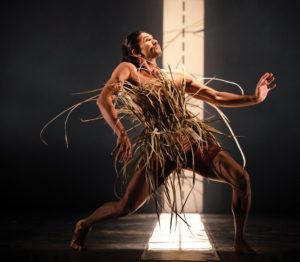Sydney & Brisbane: Fall 2019 - Vancouver Ballet Society
- Home
- City Reports 2015 - 2019
- Sydney & Brisbane: Fall 2019

By Deborah Jones
This year Bangarra Dance Theatre marks three decades of existence, a fine achievement for a contemporary dance company. It is, however, the merest sliver of time compared with the 65,000 years of First Nations history and culture that informs everything Bangarra does. Why, then, did the celebratory anniversary program include Jirí Kylián’s Stamping Ground, particularly as Bangarra has never before performed the work of a non-Indigenous choreographer? It’s a wonderful story.
The Czech master made Stamping Ground in 1983, three years after attending a vast gathering of Australian First Nations communities on Groote Eylandt. Kylián was deeply moved by the centrality of dance in Indigenous Australian life — the necessity of it, really. Dance contained history and stories, expressed spirituality and was the common language for people who spoke many different tongues.
Kylián’s experience “influenced each and every work he has created since then,” said Roslyn Anderson, Kylián’s Australian-born assistant choreographer, who staged Stamping Ground for Bangarra, in a program note. It’s hard to overestimate this tremendous gift to contemporary dance.
Bangarra artistic director Stephen Page had an abundant repertoire to choose from for the “30 years of sixty five thousand” program, much of it his own work, so the recognition of Kylián was graceful and timely.
Presented at the Sydney Opera House, the program opened with Frances Rings’ Unaipon from 2004. It explored the culture and ideas of an Ngarrindjeri man, David Unaipon, in seven sections that alluded to his work as a preacher, inventor and philosopher (he died in 1967). There was a trance-like quality to much of the dance language as Rings placed Unaipon’s thinking in a universal context. And nothing was lovelier than the work’s night-sky opening, in which we heard Unaipon’s suggestion that the source of life is to be found “in another world — yet we are here.”
Otherworldliness permeated Unaipon. A section based on string games was grounded in the reality of traditional Ngarrindjeri life but abstracted into something grand and mysterious, as was Rings’ depiction of the four winds, representing knowledge of the land. Swirling bodies evoked Unaipon’s interest in the laws of motion and the rapt calmness his Christian faith. The music, lush with language and song, came chiefly from the hand of David Page. He died in 2016 but his wonderful score lives on.
Stamping Ground opened the second half and was pure joy. Six dancers were introduced individually with a silent solo and the piece then headed into exhilarating, hard and fast duos and trios to a percussion work by Carlos Chávez. It was forceful, witty and 100 per cent Kylián but with touches of the inspiration — not imitation, he stressed — that guided him. The alert use of head, eyes and neck and springy, agile knees were particularly notable. The Bangarra cast danced Stamping Ground with splendidly earthy vigour and made it their own.
The program ended satisfyingly with To Make Fire, a blending of sections from earlier Bangarra works.
There was more Kylián over at Queensland Ballet when Soldier’s Mass (1980) provided the highlight of the Brisbane-based company’s contemporary triple bill, Masters Series, at Queensland Performing Arts Centre. With Bohuslav Martinu’s anguished Field Mass (1939) ringing in their ears, 12 young men faced war and their fears, buffeted by fate and heading for a conclusion never in doubt. The distinction between the soldiers they were forced to be and the community they once were was constantly blurred as formal battle formations gave way to group folk dances and gestures of tender support.
To the sound of martial trumpets, drums that cracked like bullets and a stirring male choir, the men advanced and retreated, gathered and dispersed. Individuals emerged momentarily, but were inexorably subsumed back into the pack. Martinu, who like Kylián was born in Czechoslovakia, wrote this music in 1939 in support of the Resistance after the Nazis invaded his homeland. You would need a heart of stone to remain unmoved.
The QB men danced Soldier’s Mass with affecting seriousness and purpose, even if the commanding groundedness of Kylián’s style wasn’t entirely captured by all.
George Balanchine’s glorious Serenade (1935), a love letter to the language and history of classical dance, opened the program. Has any other choreographer made fifth position of arms and feet look more radiant? The QB women were lustrous at both performances I saw, particularly Lucy Green as the Russian Girl in the first cast.
Serenade and Soldier’s Mass bookended American choreographer Trey McIntyre’s new The Shadows Behind Us, a minor work in which six glamorous couples enacted romantic entanglements in busy vignettes mixing ballet and ballroom. The quirky moves and complicated, often awkward-looking partnering may have been more persuasive had there been a better fit between dance and music.
The Shadows Behind Us was set to six popular songs given slow, torchy treatment by jazz singer Jimmy Scott. The selections included Unchained Melody, Our Day Will Come and, disconcertingly, Exodus, written for the film of that name about the founding of Israel. It made sense to read in the program that McIntyre “doesn’t really listen to the lyrics in pop songs.” Shadows may have been rather more memorable if he had a different view.

Photo: Dan Boud
